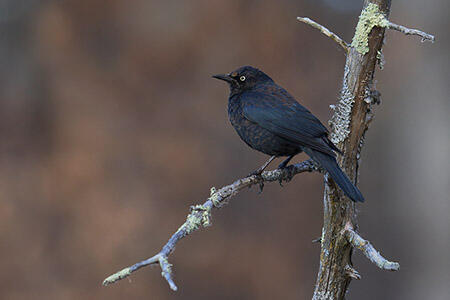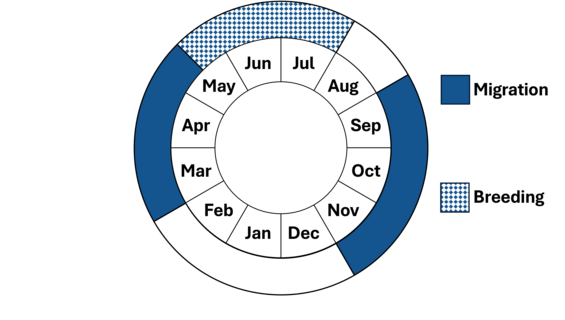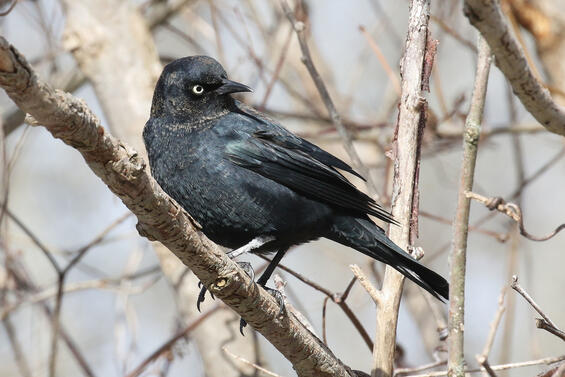- Scientific name: Euphagus carolinus
- Species of Greatest Conservation Need (MA State Wildlife Action Plan)
Description

Rusty blackbird (Euphagus carolinus)
The rusty blackbird is superficially similar to other species of blackbirds (red-winged blackbird and common grackle), but its affinity for remote spruce bogs and solitary nature during the breeding season set it apart from its more gregarious and marsh-loving cousins. In breeding plumage, the rusty blackbird is bluish-black with no obvious markings, but its post-breeding plumage is distinctive with rusty-brown patches on its back and brown barring on its chest and flanks. The rusty blackbird is far more likely to be encountered during migration when it joins mixed flocks with other blackbird species and forages along the edges of flooded swamps and agricultural fields.
Life cycle and behavior

Figure 1. Phenology in Massachusetts. This is a simplification of the annual life cycle. Timing exhibited by individuals in a population varies, so adjacent life stages generally overlap each other at their starts and ends.
This species winters throughout the midwestern and southeastern United States. It is an early spring migrant the moves through Massachusetts in March and April. Nesting typically begins in May. Nests are often placed against the bole of a conifer tree in a clump of small branches. Clutch size ranges from 3-5 eggs, incubation last for 11-12 days, and chicks fledge from the nest 10-13 days following hatching. Little is known about the birds after fledging. Fall migration peaks in October.
Population status
Concern for this species has been amplified range-wide during the last 20 years, as wintering and breeding estimates seem to be crashing. Rusty blackbird Breeding Bird Survey data is not available for Massachusetts, but across North America there was an annual decline of 2.6% between 1966-2022. However, much of the population breeds north of survey routes, and the decline is thought to be much more dramatic (up to 95% population loss since 1970).
Distribution and abundance
Rusty blackbirds were never common breeders in Massachusetts, relegated to a few sites in northern Berkshire and Franklin counties. They were present and confirmed at several sites in the Massachusetts Breeding Bird Atlas 1. In fact, the first nest ever found of this species in Massachusetts was collected from a swamp in Savoy Mountain State Forest in 1977 during an Atlas 1 survey. There were only a few reports during Atlas 2, and none were confirmed. Sometime between Atlas 1 and 2, this species appears to have been extirpated from Massachusetts as a breeding bird.

Rusty blackbird (Euphagus carolinus)
Habitat
Historically, breeding rusty blackbirds in Massachusetts were associated with remote spruce bogs in the high elevations of northern Berkshire and Franklin counties. Small openings are favorable for nesting, as well as aggregations of dense spruce and fir saplings at the nest microsite. Fire and beaver activity are thought to provide important disturbance events that shape ideal nesting habitat.
In migration, rusty blackbirds are found as solitary birds, in small groups, or in large mixed-species flocks associated with wooded swamps or flooded agricultural fields where they forage on the ground, often at the water’s edge.
Healthy habitats are vital for supporting native wildlife and plants. Explore habitats and learn about conservation and restoration in Massachusetts.
Threats
Potential factors promoting the dramatic, range-wide decline of rusty blackbirds include loss of wetlands used by wintering individuals in the Southeast, habitat degradation and contaminants on breeding grounds, poisoning targeting other species of blackbirds at wintering roosts, and increasing disturbance of boreal wetlands where this species breeds. Alone, none of these factors appears adequate to account for the broad and extraordinary loss in numbers of this species, so it is likely that the decline is a result of synergistic effects.
An additional threat to the species is collisions with buildings and other structures, as approximately 1 billion birds in the United States are estimated to die annually from building collisions. A high percentage of these collisions occur during the migratory periods when birds fly long distances between their wintering and breeding grounds. Light pollution exacerbates this threat for nocturnal migrants as it can disrupt their navigational capabilities and lure them into urban areas, increasing the risk of collisions or exhaustion from circling lit structures or areas.
Conservation
Conservation of forest habitat on the breeding grounds will benefit rust blackbirds as large-scale clearcutting reduces habitat for the species and may allow invasion of other blackbird species (e.g., common grackle, red-winged blackbird). Studies suggest that providing a no-logging buffer of 50-100m (~55-110 yds) around wetlands occupied by breeding rusty blackbirds would result in increased reproductive success.
Bird collision mortalities can be minimized by making glass more visible to birds. This includes using bird-safe glass in new construction and retrofitting existing glass (e.g., screens, window decals) to make it bird-friendly and reducing artificial lighting around buildings (e.g., Lights Out Programs, utilizing down shielding lights) that attract birds during their nocturnal migration.
References
Avery, M. L. (2020). Rusty Blackbird (Euphagus carolinus), version 1.0. In Birds of the World (A. F. Poole, Editor). Cornell Lab of Ornithology, Ithaca, NY, USA. https://doi.org/10.2173/bow.rusbla.01
Breeding Bird Atlas Explorer (online resource). 2022. U.S. Geological Survey Patuxent Wildlife Research Center. <2015-02-15>. http://www.pwrc.usgs.gov/bba. Data compiled from: Massachusetts Breeding Bird Atlas 2007-2022
Veit, R.R, and W.R. Petersen. 1993. Birds of Massachusetts. Massachusetts Audubon Society, Lincoln MA.
Contact
| Date published: | April 24, 2025 |
|---|